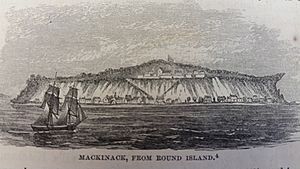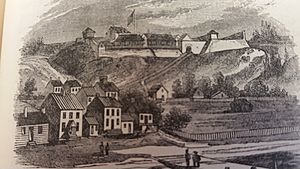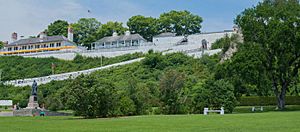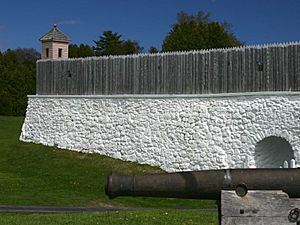Fort Mackinac facts for kids
|
Fort Mackinac
|
|
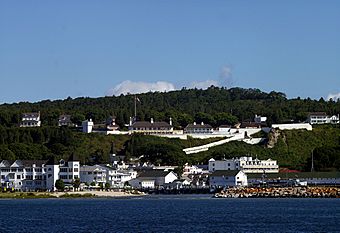
Fort Mackinac
|
|
| Location | Huron Rd., Mackinac Island, Michigan |
|---|---|
| Built | 1782 |
| NRHP reference No. | 70000280 |
Quick facts for kids Significant dates |
|
| Added to NRHP | October 31, 1966 |
| Designated | June 9, 1960 |
Fort Mackinac (pronounced MAK-ə-naw) is an old military fort on Mackinac Island, Michigan. It was used by both British and American soldiers for over 100 years. The fort is located on Mackinac Island in the Straits of Mackinac, a narrow waterway connecting Lake Michigan and Lake Huron.
The British first built the fort during the American Revolutionary War (1775-1783). They wanted to control the important fur trade in the Great Lakes region. Later, the fort was involved in two big battles during the War of 1812. After that, it became a United States Army outpost. Today, Fort Mackinac is a popular museum where you can learn about its exciting past. It's part of Mackinac Island State Park.
Contents
Fort Mackinac's Early History
Building the Fort During the Revolution
Before 1763, the French had a fort called Fort Michilimackinac on the mainland. After the French and Indian War, the British took over this fort. However, they thought it was too hard to defend.
So, in 1780, the British decided to build a new, stronger fort. They chose a high, rocky cliff on Mackinac Island, about 150 feet (46 meters) above the water. This new fort, made of limestone, was much easier to protect. The British kept control of this important outpost throughout the American Revolutionary War.
Handing Over the Fort to America
Even though the American Revolutionary War ended in 1783, the British did not give up Fort Mackinac right away. They finally handed it over to the United States in 1796. This was 13 years after the war ended, following a special agreement called the Jay Treaty.
Battles of the War of 1812
British Capture of Fort Mackinac (1812)
In June 1812, the United States declared war on Great Britain. British Major-General Isaac Brock quickly sent word to attack Fort Mackinac. At the time, only about 60 American soldiers were stationed there. Their commander, Lieutenant Porter Hanks, had not heard about the war.
On July 17, 1812, a large force of British soldiers and Native American allies attacked the fort. They landed quietly on the island and set up cannons. Lieutenant Hanks and his men were completely surprised. They were badly outnumbered and feared a massacre by the Native American warriors. So, Lieutenant Hanks surrendered the fort without a fight. The British let the American soldiers go, but made them promise not to fight again in the war.
American Ships Captured
Soon after, two American ships arrived at the island, not knowing the fort had been captured. The British cleverly raised the American flag. When the ships docked, the British captured them as prizes of war. One of these ships, the Friends Good Will, was even used by the British navy!
Building Fort George
After taking the island, the British built an even stronger fort. They called it Fort George. This new fort was on the highest point of the island. It had a wooden fence (stockade) and a strong blockhouse. This was to make sure the Americans couldn't easily take the island back. Sadly, Lieutenant Hanks, who surrendered Fort Mackinac, was later killed in another battle before he could face a military trial.
America Tries to Retake the Fort (1814)
Two years later, in July 1814, American forces tried to get Mackinac Island back. Colonel George Croghan led about 700 soldiers on five ships. They planned to attack Fort George.
However, Colonel Croghan found that the new British fort was too high up for his ships' cannons to reach. This meant his soldiers would have to attack on foot, without much cover. After two days of shelling that mostly missed, a thick fog forced the Americans to retreat for a week.
The Battle of Mackinac Island
When the Americans returned, they landed on the north side of the island. Major Andrew Holmes led the soldiers through thick woods towards Fort George. As they came out of the trees, British soldiers and Native American allies were waiting. The British had cannons and guns hidden behind low walls.
The British fired on the Americans, causing heavy losses. Thirteen Americans were killed, including Major Holmes, and 51 were wounded. Colonel Croghan had to order his men to retreat. The Americans got back on their ships and left.
This defeat meant the British kept Mackinac Island until the end of the War of 1812. After the war ended in 1815, the Americans got the fort back. They renamed Fort George to Fort Holmes, honoring Major Holmes who died in the battle.
Fort Mackinac's Later Years
A Changing Role for the Fort
After the War of 1812, Fort Mackinac was no longer needed to defend against the British. It became a place where soldiers could be stationed until they were needed elsewhere. It also served as an important fur trading post.
From 1816 to 1821, Benjamin Kendrick Pierce commanded the fort. He was the older brother of future President Franklin Pierce.
Doctor Beaumont and Digestion
In 1822, something amazing happened at the fort. A fur trader named Alexis St. Martin was accidentally shot in the stomach. The fort's doctor, William Beaumont, treated him. St. Martin survived, but he had a hole in his stomach that never fully closed.
Dr. Beaumont saw this as a unique chance to study how digestion works. He performed experiments on St. Martin, observing how food was broken down inside his stomach. Dr. Beaumont wrote a book about his discoveries and is now known as the "Father of Gastric Physiology."
Exploring the Michigan Territory
Fort Mackinac also played a role in exploring the northern Michigan Territory. In 1820, an expedition led by Lewis Cass started from the fort to explore the source of the Mississippi River.
Later, in the 1830s, Henry Rowe Schoolcraft worked at the fort as a United States Indian agent. He studied Native American languages and culture, helped by his wife, Jane Johnston Schoolcraft, who was of Ojibwe and French heritage.
The Civil War and Beyond
During the Mexican–American War and parts of the American Civil War, the fort was often left with just one soldier, an ordnance sergeant, to look after it. However, during the Civil War, it briefly held three Confederate political prisoners. These prisoners had some freedom but were guarded by local volunteers. Two of them eventually signed loyalty oaths and were released.
In 1872, a US Army officer and artist named Seth Eastman painted a picture of Fort Mackinac. This painting is now in the collection of the United States Senate.
Mackinac National Park Years
Soldiers as Park Rangers
From 1875 to 1895, Fort Mackinac and much of Mackinac Island became Mackinac National Park. This was the second national park in the United States, after Yellowstone National Park. During these years, the soldiers stationed at the fort acted as park rangers. They helped maintain the park, building new roads and footpaths.
The Army also tried to make life better for the soldiers. They built a bathhouse, flush toilets, and a canteen where soldiers could relax, read, play pool, and buy beer. Soldiers still had their regular military duties, like drilling and target practice. These skills were useful for many who later served in the American West.
Fort Mackinac Today
Becoming a State Park
In 1895, the US Congress closed Fort Mackinac and Mackinac National Park. The fort and park were given to the State of Michigan. This created Mackinac Island State Park, Michigan's very first state park.
Today, the Mackinac Island State Park Commission manages Fort Mackinac and other historic sites. They work to preserve and share the rich history of Mackinac Island. Most of the money to run the park comes from admission fees, not from public taxes.
Visiting the Fort Today
Fort Mackinac is now a popular place for visitors. It's one of the best-preserved early forts in the country. In 2015, the fort celebrated 235 years since it was first built!
During the summer, the fort is full of activity. Costumed interpreters dress as soldiers from the 1880s. They greet visitors, answer questions, and lead tours. You can see "soldiers" firing original 45-70 Springfield Model 1873 rifles, just like they did long ago.
You can also watch a large 1841 model six-pounder cannon being fired daily. Other activities include court martial re-enactments and dances with live music. It's a great way to step back in time and experience life at a historic fort!
Original Buildings to Explore
There are 14 original buildings at Fort Mackinac that you can visit:
- Commissary Building: This was used to store food. Now it shows a video about the fort.
- Post Headquarters: This building held offices and the paymaster.
- Quartermaster's Storehouse: All the equipment for the soldiers was kept here.
- Post Bathhouse: Built in 1885, this building had six baths for soldiers.
- Soldiers Barracks: Over 100 soldiers lived here. Today, it's a museum and gift shop.
- Post Schoolhouse: Soldiers could get an education in this building.
- Hill Quarters: Many lieutenants lived in these officers' homes.
- Post Hospital: The fort's doctor treated patients here.
- Officer's Stone Quarters: This is Michigan's oldest building, built in 1780. It housed officers and now has the Kids Quarters and a Tea Room.
- Wood Quarters: This building had many uses, including officers' quarters and a canteen.
- Post Guardhouse: Prisoners were held in this building for over 100 years.
- North, East, and West Blockhouses: These stone towers were built by the first American soldiers at the fort.
See also
- Mackinaw jacket, a type of coat created at Fort Mackinac in 1812.




